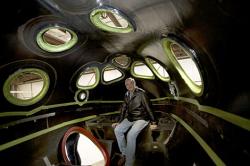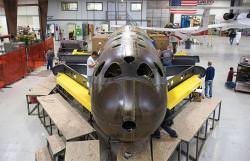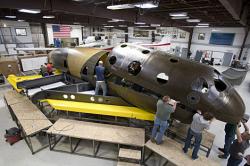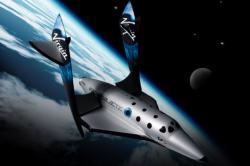It is really taking shape. The future of Virgin Galactic’s fleet of space tourism rockets is currently forming in a non-descript factory in the Mojave Desert, California. As if to prove that the Scaled Composite-design is not a pipe dream, pictures of the first commercial spaceflight vehicle have been released. It looks fairly crude and welded together, but this forms the bare bones of the worlds first viable hi-tech space tourism vehicle. All it needs now are some windows, seats, wings and an engine and we’re good to go!

It is as if Scaled Composites wanted to trump their competitor’s cards with proof that the SpaceShipTwo design is more than just a concept. It seems that everyone is claiming a portion of the space tourism industry, including economy class. Nancy covered XCOR’s press release (26th March) that the company was designing a smaller, cheaper, economy-class space plane, designed to take two people into low-Earth orbit (note: lower Earth orbit than Virgin Galactic’s design). Even the rocket builder Astrium has gotten in on the act, claiming that there will be a market for their mass-produced conventional space plane (18th March), releasing some uber-cool images and simulations of the craft in action.
So the economy-class market has been claimed by XCOR and Astrium has grabbed the “AirBus-in-space” mass-production market. But in the aim to prove that “the original and the best” concept is actually growing beyond the design phase and in full production, Scaled Composites are proving that their spaceship is one step closer than all their competitors: they’re building their spaceship right now.
To rub it in, one photo shows Burt Rutan sitting proudly inside the shell of the SpaceShipTwo cockpit proving they are accelerating production toward a 2009 test-run. These new images are from the production line in a factory in the Californian Mojave Desert.
SpaceShipTwo will carry six people into the lower limit of space and will experience a few minutes of weightlessness. The craft will be helped on its way by the WhiteKnightTwo aircraft, giving the rocket a piggyback ride to 50,000 ft. At this height, SpaceShipTwo will be released and its rockets will blast to life taking the first tourists into space. You can find out more about SpaceShipTwo in a previous Universe Today story.
Source: Popular Mechanics




sounds good!
awwwww
I hope this works out well and they produce more and reduce costs over time. If I could justride in one once before I die I would be fulfilling a life dream.
I agree with Quasidog, If I had a couple a hundred grand I’d happily die after a trip like that crazy as it sounds. This should all have happened such a long time ago. Branson is a hero for single handedly making this happen. Rutan’s reentry method is genius! Words fail me *tears* ha ha..
“the company was designing a smaller, cheaper, economy-class space plane, designed to take two people into low-Earth orbit (note: lower Earth orbit than Virgin Galactic’s design)”
Neither of these vehicles are going into low Earth orbit. – a sub-orbital lob, maybe, but not orbit.
It’s exciting to see some new pictures of what will likely be the first dedicated tourist spacecraft. I cannot wait to see this thing launched!
Ross, thank you for pointing that out. I had wondered about the accuracy of calling, what is essentially a dramatic parabolic arc into the upper atmosphere, a Low Earth Orbit.
I think that what we’re seeing are the baby Steps in space flight, comparable to the “Flight’ of the Wright Brothers, which by today’s standards is not anything remarkable but took place only a little over a century ago.
As long as it’s not full of drunken chavs, as happens every time I go abroad, I’d love to try it
What happens if one of the wings fails to come out of feather for the landing? Seems a bit dangerous.
As I recall from listening to Burt’s talk at Oshkosh a few years back, they expected a crash in the feathered condition to likely be survivable in SS1, anyway. Memory could be wrong, but it had to do with the terminal velocity on the feathered condition and the shock absorbing qualities of the landing gear and composite structure. Wouldn’t be much fun, and you wouldn’t “walk away”, but I believe they thought it would be survivable at least. The mechanism itself was fairly simple and reliable, and I would assume they are largely just scaling it up.